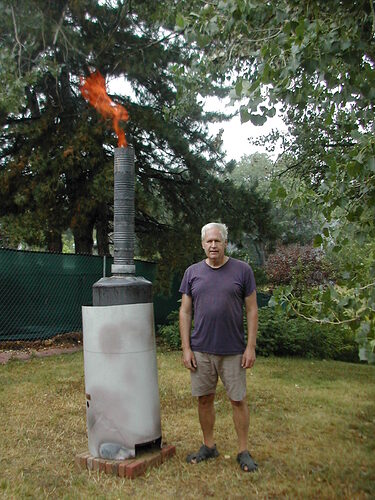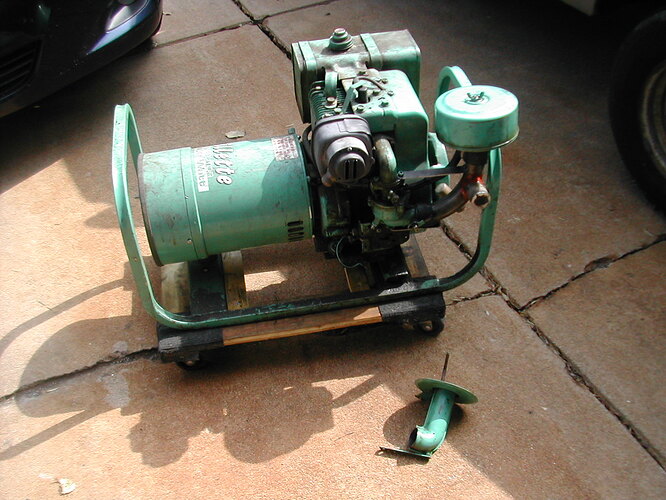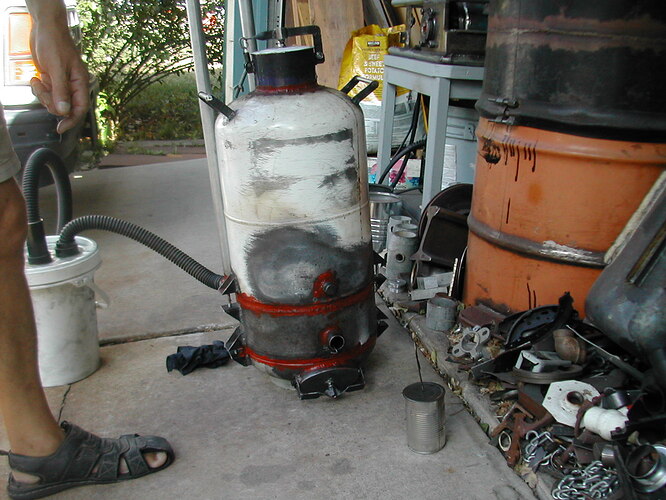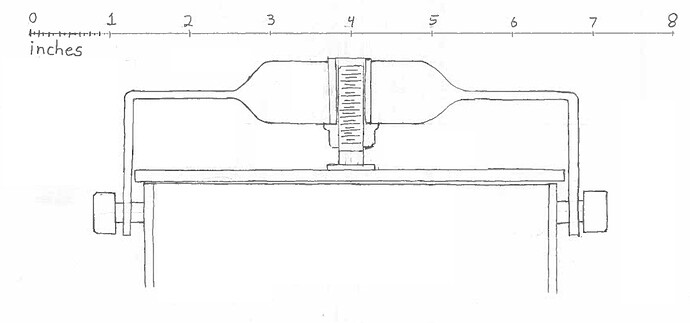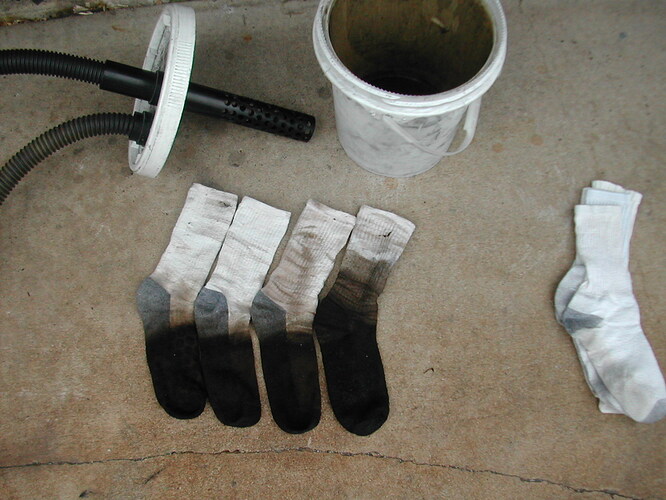Errr. Grate blow off nozzle. That’s something that Tone Šuštarič came up with for his ‘Fergi’ tractor on the Tractor with gas? thread. LINK
Rindert
Yes, I know. Do you have a sketch or pictures of your nozzle grid construction?
thierry, how your air cooled nozzle works?
excuse , this was another topic…but i cannot find it now…
Hi Giorgio, you’re right, I’m not very good at keeping track of my projects.
As for the air-cooled nozzle, I don’t talk about it anymore because it’s always in the workshop and I never have time to work on it. I’m glad you’re interested in this project, and when I work on it again, I’ll let you know.
I’m working on that. I’m going to run the gasifier once more today. And if it goes the way I hope it will I’ll make a good, full scale, pencil drawing, have it scanned and post it here.
I made a bunch of layout sketches. I know what I was doing and thinking, but it’s just a mess if anyone else looks at it.
Rindert
Hello Rindert, I like your term “grill blowing nozzle”, you definitely have an interesting gasifier design that can work on a mixture of wood and charcoal. The “main focus” is created above between the three nozzles, which the gas flow pushes down towards the outlet openings, well, here you have an additional source of oxygen for burning fine charcoal mixed with ash, which loosens this content below and the gas flow carries the ash through the outlet openings without much resistance. The essence of this method is the ratio between the size of the air inlet openings, which ratio is right for your gasifier, you will find out during use. With Fergi, the ratio is about 1:15, the lower nozzle has a 6 mm inlet opening, into which I can push a wire and thus reduce the air flow, in the connection you can see the bent wire in the shape of a loop, but this muffled the air flow a little too much (interestingly, Mr. Don didn’t notice this either) ![]()
Interesting! I didn’t know you were restricting the airflow to the grate blow-off nozzle. @trigaux called it a grill blowing nozzle. I don’t know which is better. I think this is working very well because I haven’t had any problems with the char bed being restrictive. I am not sure that I need the little screw with the wire welded on it.
I have three main nozzles .227 inches (5.77mm) diameter. The main nozzles are arranged to create a vortex and they are angled slightly upward. Nozzles to restriction distance is 8.1 inches (206mm). Restriction is a simple piece of cast iron, ~3 pounds (1.5Kg), with a 1 inch (25mm) square hole. The first time I used it it bridged. After this, never.
This one makes little power when using pure charcoal. When I used 1/3 raw wood much more power. I will try it with more raw wood soon.
I didn’t know if it was going to work so I didn’t install a port to remove ashes. Today I began working on this. Tomorrow I will see what the ashes look like.
Also, I am making a better paper drawing.
Rindert
I took the ash pit off. Nothing seems bad. There is a lot of very fine black powder with some charcoal pieces. I am going to add it back into the gasifier, around the outer edge, so it will help build the ash cone.
I started the engine on gasoline. I started right up and didn’t do anything strange, so I think it does not have tar in it.
The filter I made out of a bucket and socks seems to be working well. So far I haven’t collected any condensate from this gasifier. I wonder if this means I can use wetter fuel? Or maybe I just need a better gas cooler?
Rindert
If I were you, I would try to insert a suitably large pipe that would hold the insulation with ash, while at the same time preventing the flow of tar gases (if you use wood) down the outer wall…
I will remember this if it makes tar.
Rindert
Making charcoal. 50 gallons of dry wood usually makes 35 gallons of charcoal. I use the TLUD (Top Lit Up Draft) method.
Rindert
I had to make a new air intake for the old Briggs. The old, very thin, sheet metal one just wouldn’t hold vacuum well enough to allow me to control the air and fuel mixture when running on woodgas.
Rindert
I put in an ash clean-out port.
I ran the generator for about 40 minutes. This time I used a little more raw wood, about 50% wood and 50% charcoal. I got a little more power. I’m waiting for two 15A Kill-A-Watt meters I ordered on Amazon.
Rindert
Here’s a drawing of the closure for the ash cleanout.
50% wood is too much. I had a lot of tar in the filter. Time for new socks. But this kind of filter is very good, I think. Because it protected my engine.
Rindert
Are you still just experimenting or do you think you need the extra power by adding wood? I think it is pretty well established that small engines are the safest with a diet of charcoal.
All of the above. I’m mostly trying to get as much of ‘the other 75%’ as I can before I move on to the next phase. But of course who wouldn’t want more power? And 1.2KW out of a 3KW generator doesn’t seem like much. Kristijan talked about “rocket fuel”. I estimate that I have a 4 inch layer of ash and char surrounding the reaction zone. I thought that that much insulation might hold in the heat a little better allow this setup to do a some things others don’t. You never know if you don’t try.
Rindert
rindert,how much dust you catch with the socks normally? have you a picture of throttle and spark plug after some hours of running time?
with a cage instead of tube with holes would be possible to achieve more active filter surface and getting a breathing filter, but to whom i tell this…
I don’t take it apart unnecessarily because it always starts and runs perfectly.
Yes I have thought about this, but this filter is working very well. I have seen a filter for milk that used a spring instead of a tube. It also worked very well.
Rindert
yes, i understand, the throttle block on briggs engines is to remove a bit difficult, also the spark plug…i asked because my experience with dry foam filters - easy system -was not so good, because fine dust goes through after a while…therefore i work with wet filters now, but this is more complex…the simplicity of some socks would be hard to beat if they are able to hold also the finer dust in dry filtering method.
more working hours , continous runs shows us how good is the filtering… if the filter is less good, with a while layers of dust accumulate on the throttle and can block it, and the spark plug gets also dirty, from my experience…maybee this is not to see when starting and end of running is with gasoline, because maybee it cleans all away, but than real working conditions of the filter are not clear…
trust is good, control is better …






